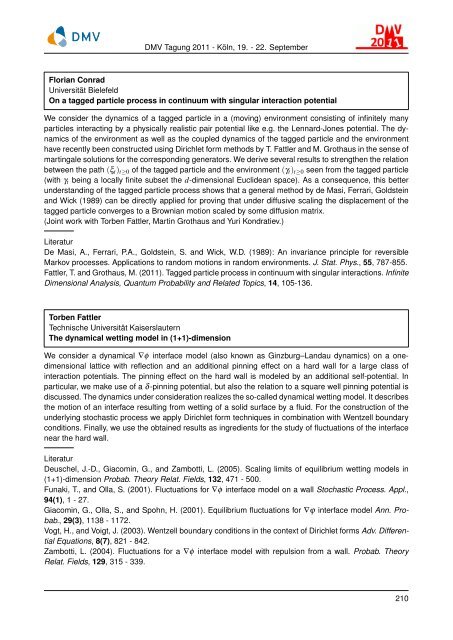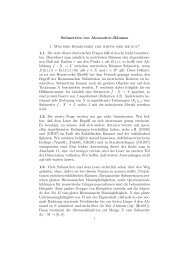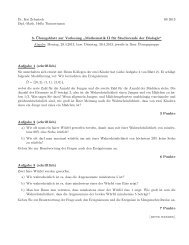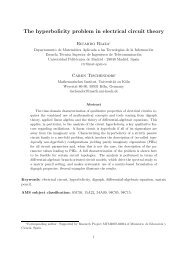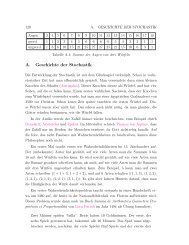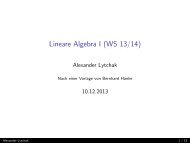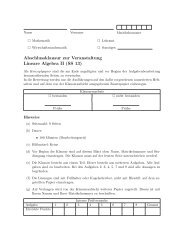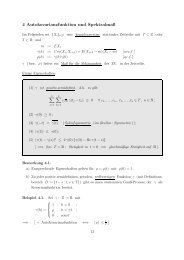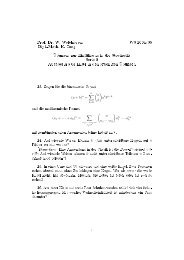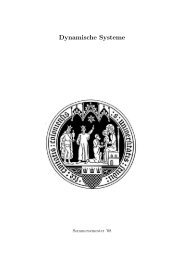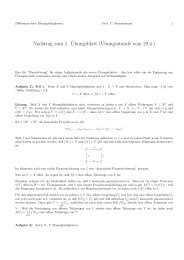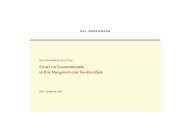Inhaltsverzeichnis - Mathematisches Institut der Universität zu Köln
Inhaltsverzeichnis - Mathematisches Institut der Universität zu Köln
Inhaltsverzeichnis - Mathematisches Institut der Universität zu Köln
You also want an ePaper? Increase the reach of your titles
YUMPU automatically turns print PDFs into web optimized ePapers that Google loves.
DMV Tagung 2011 - <strong>Köln</strong>, 19. - 22. September<br />
Florian Conrad<br />
<strong>Universität</strong> Bielefeld<br />
On a tagged particle process in continuum with singular interaction potential<br />
We consi<strong>der</strong> the dynamics of a tagged particle in a (moving) environment consisting of infinitely many<br />
particles interacting by a physically realistic pair potential like e.g. the Lennard-Jones potential. The dynamics<br />
of the environment as well as the coupled dynamics of the tagged particle and the environment<br />
have recently been constructed using Dirichlet form methods by T. Fattler and M. Grothaus in the sense of<br />
martingale solutions for the corresponding generators. We <strong>der</strong>ive several results to strengthen the relation<br />
between the path (ξt)t≥0 of the tagged particle and the environment (γt)t≥0 seen from the tagged particle<br />
(with γt being a locally finite subset the d-dimensional Euclidean space). As a consequence, this better<br />
un<strong>der</strong>standing of the tagged particle process shows that a general method by de Masi, Ferrari, Goldstein<br />
and Wick (1989) can be directly applied for proving that un<strong>der</strong> diffusive scaling the displacement of the<br />
tagged particle converges to a Brownian motion scaled by some diffusion matrix.<br />
(Joint work with Torben Fattler, Martin Grothaus and Yuri Kondratiev.)<br />
Literatur<br />
De Masi, A., Ferrari, P.A., Goldstein, S. and Wick, W.D. (1989): An invariance principle for reversible<br />
Markov processes. Applications to random motions in random environments. J. Stat. Phys., 55, 787-855.<br />
Fattler, T. and Grothaus, M. (2011). Tagged particle process in continuum with singular interactions. Infinite<br />
Dimensional Analysis, Quantum Probability and Related Topics, 14, 105-136.<br />
Torben Fattler<br />
Technische <strong>Universität</strong> Kaiserslautern<br />
The dynamical wetting model in (1+1)-dimension<br />
We consi<strong>der</strong> a dynamical ∇φ interface model (also known as Ginzburg–Landau dynamics) on a onedimensional<br />
lattice with reflection and an additional pinning effect on a hard wall for a large class of<br />
interaction potentials. The pinning effect on the hard wall is modeled by an additional self-potential. In<br />
particular, we make use of a δ -pinning potential, but also the relation to a square well pinning potential is<br />
discussed. The dynamics un<strong>der</strong> consi<strong>der</strong>ation realizes the so-called dynamical wetting model. It describes<br />
the motion of an interface resulting from wetting of a solid surface by a fluid. For the construction of the<br />
un<strong>der</strong>lying stochastic process we apply Dirichlet form techniques in combination with Wentzell boundary<br />
conditions. Finally, we use the obtained results as ingredients for the study of fluctuations of the interface<br />
near the hard wall.<br />
Literatur<br />
Deuschel, J.-D., Giacomin, G., and Zambotti, L. (2005). Scaling limits of equilibrium wetting models in<br />
(1+1)-dimension Probab. Theory Relat. Fields, 132, 471 - 500.<br />
Funaki, T., and Olla, S. (2001). Fluctuations for ∇φ interface model on a wall Stochastic Process. Appl.,<br />
94(1), 1 - 27.<br />
Giacomin, G., Olla, S., and Spohn, H. (2001). Equilibrium fluctuations for ∇ϕ interface model Ann. Probab.,<br />
29(3), 1138 - 1172.<br />
Vogt, H., and Voigt, J. (2003). Wentzell boundary conditions in the context of Dirichlet forms Adv. Differential<br />
Equations, 8(7), 821 - 842.<br />
Zambotti, L. (2004). Fluctuations for a ∇φ interface model with repulsion from a wall. Probab. Theory<br />
Relat. Fields, 129, 315 - 339.<br />
210


